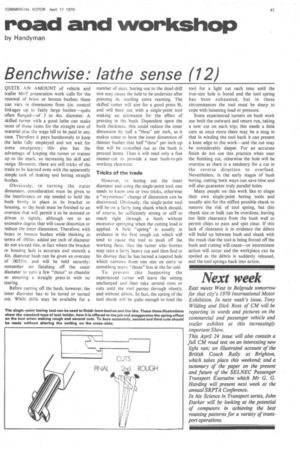road and workshop
Page 43

If you've noticed an error in this article please click here to report it so we can fix it.
by Handyman
Benchwise: lathe sense (12)
QUITE AN AMOUNT of vehicle and trailer MoT preparation work calls for the renewal of brass or bronze bushes; these can vary in dimensions from +in. control linkages up to fairly large bushes—quite often flanged—of 3 to 4in. diameter. A skilled turner with a good lathe can make most of these items for the straight cost of material plus the wage bill to be paid in any case. Therefore it pays handsomely to keep the lathe fully employed and not wait for some emergency; this also has the advantage of keeping the turner or trainee up to the mark, so increasing his skill and range. However, there are still tricks of the trade to be learned even with the apparently simple task of making and boring straight bushes.
Obviously, in turning the outer dimension, consideration must be given to the interference or nip needed to hold the bush firmly in place in its bracket or housing, so the bush must be finished to an oversize that will permit it to be stressed or driven in tightly, although not to an excessive degree that will cause distortion or reduce the inner dimension. Therefore, with brass or bronze bushes while thinking in terms of .001in. added per inch of diameter do not exceed this, in fact where the bracket or housing hole is accurate and smooth a 4in. diameter bush can be given an oversize of .0035in, and will be held securely; remember on finishing off the outer diameter to turn a few "thous" to chamfer so ensuring a straight press-in with TIO tearing.
Before parting off the bush, however, the inner diameter has to be bored or turned out. While drills may be available for a number of sizes, boring out to the dead-drill size may cause the hole to be undersize after pressing in, needing extra reaming. The skilled turner will aim for a good press fit, and will bore out with a single-point tool making an allowance for the effect of pressing in the bush. Dependent upon the bush thickness, this could reduce the inner dimension by half a "thou" per inch, so it makes sense to bore the inner dimension of thinner bushes that half "thou" per inch up that will be cancelled out as the bush is pressed home. f hen it will need only a fine reamer-cut to provide a neat bush-to-pin working clearance.
Tricks of the trade However, in boring out the inner diameter and using the single-point tool, one needs to know one or two tricks, otherwise a "mysterious" change of dimension can be discovered. Obviously, the single-point tool will he no a fairly long shank which should, of course, be sufficiently strong or stiff to reach right through a bush without excessive springing when the cutting load is applied. A little "spring" is usually in evidence in the first rough cut which will tend to cause the tool to push off the working face; thus the turner who hurries may take a fairly heavy cut and then find to his dismay that he has turned a tapered hole which narrows from one size on entry to something many "thous" less at the far end.
To prevent this happening the experienced turner will leave the setting unchanged and then take several runs or cuts until the tool passes through silently and without debris. In fact, the spring of the tool shank will he quite enough to load the tool for a light cut each time until the true-size hole is bored and the tool spring has been exhausted, but in these circumstances the tool must be sharp to cope with lessening load or pressure.
Some experienced turners on bush work use both the outward and return run, taking a new cut on each trip; this needs a little care as once more there may be a snag in that in winding the tool back it can present a keen edge to the work—and the cut may be considerably deeper. For an accurate finish do not use this practice when near the finishing cut, otherwise the hole will be oversize as there is a tendency for a cut in the reverse direction to overfeed. Nevertheless, in the early stages of bush boring, cutting both ways can save time and will also guarantee truly parallel holes.
Many people on this work like to shape their own single-point boring tools and usually aim for the stiffest possible shank to remove the risk of tool spring, but this shank size or bulk can be overdone, leaving too little clearance from the bush wall to permit chips to pass and spin clear. If this lack of clearance is in evidence the debris will build up between bush and shank with the result that the tool is being forced off the bush and cutting will cease-or intermittent action will occur and the workpiece can be spoiled as the debris is suddenly released, and the tool springs back into action.












































































































